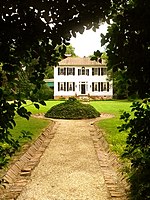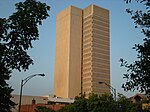Col. Elias Earle Historic District
Colonial Revival architecture in South CarolinaHistoric districts in Greenville County, South CarolinaHistoric districts on the National Register of Historic Places in South CarolinaHouses in Greenville, South CarolinaHouses on the National Register of Historic Places in South Carolina ... and 6 more
NRHP infobox with nocatNational Register of Historic Places in Greenville, South CarolinaNeoclassical architecture in South CarolinaTudor Revival architecture in South CarolinaUpstate South Carolina Registered Historic Place stubsUse mdy dates from August 2023

Col. Elias Earle Historic District is a national historic district located at Greenville, South Carolina. It encompasses 74 contributing buildings in a middle-class neighborhood of Greenville. The houses primarily date from about 1915 to 1930, and include Neoclassical, Colonial Revival, Tudor Revival, and bungalow styles. The district was originally part of the estate of Colonel Elias Earle, a prominent early-19th century Greenville citizen. The Earle St. Baptist Church is located in the district.It was added to the National Register of Historic Places in 1982.
Excerpt from the Wikipedia article Col. Elias Earle Historic District (License: CC BY-SA 3.0, Authors, Images).Col. Elias Earle Historic District
West Earle Street, Greenville
Geographical coordinates (GPS) Address Nearby Places Show on map
Geographical coordinates (GPS)
| Latitude | Longitude |
|---|---|
| N 34.863055555556 ° | E -82.401666666667 ° |
Address
West Earle Street 311
29609 Greenville
South Carolina, United States
Open on Google Maps









